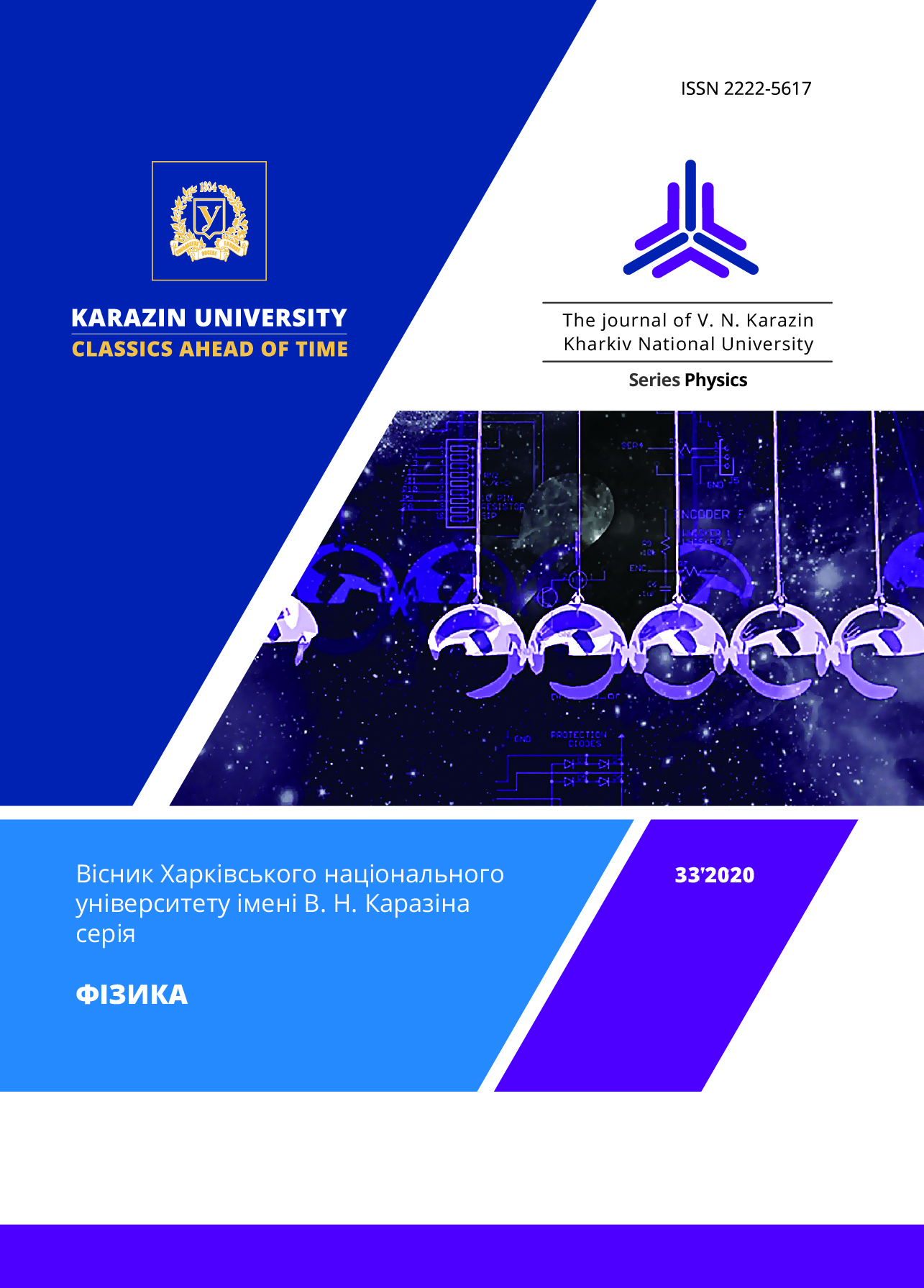Mechanisms of micro-voids formation caused by optical breakdown in KCl single crystals
Abstract
The phenomenon of optical breakdown has been studied experimentally for KCl single crystals exposed to laser emission focused on the neodymium glass with modulated quality-factor, pulse duration 5·10-8 s, wavelength λ= 1054 nm, and pulse energy of the order 1 J in the regime of local intrinsic absorption of the laser emission by the single crystal. Evaluations of local heat flash energetic constituents and characteristic durations for both local area heating and relaxation processes and following comparison with experimental results have shown that the relaxation process takes place in two stages: the first is fast phasefollowed by crowdion mass transfer with shock wave participation, and the second is slow phase with participation also dislocation mass transfer. The energy losses for heat radiation and thermal conductivity are found to be by orders of value less than the absorption energy flux Iabs that provides fast local heating and plasma formation. From the viewpoint of the mechanics of continua the process under study where the pressure achieves value exceeding the theoretical strength limit for the time less 10-6 s, should be considered as explosion-like or shock process. The general scheme of plastic deformation arising from abovementioned estimations and observations is seemed as follows. In the beginning, under action of the shock wave the crowdions are generated which carry the substance from the high pressure area and move along close-packed atomic rows (<110> type directions in KCl crystals); the void is formed almost completely during the shock wave passing the relaxation zone crosssection. This time is of the order of τrel, i. e. 10-9…10-8 s. After falling temperature and pressure and vapor condensation into liquid, at the end of relaxation process, the void boundaries expand already under liquid melt pressure, and the mass transfer dislocation mechanism comes into action providing additionally some enlarging the void volume. This process continues also after stopping the laser emission, during the crystal cooling down to the melt crystallization in the void and formation of a pore with size observed.
Downloads
References
V.N. Voevodin, I.M. Neklyudov. Evolution of the structural-phase state and radiation resistance of structural materials. (Naukova Dumka, Kyiv, 2006), 376 p. [in Russian]
V.V. Slezov, A.V. Subbotin, O.A. Osmaev. Physics of the Solid State, 47, 3, 463 (2005). [in Russian]
V.P. Veiko, M.N. Libenson, G.G. Chervyakov, E.B. Yakovlev. Interaction of laser radiation with matter. Power optics. (FIZMATLIT, Moscow, 2008), 312 p. [in Russian]
N.V. Kamyshanchenko, V.V. Krasilnikov, I.M. Neklyudov, A.A. Parkhomenko. Physics of the Solid State, 40, 9, 1631 (1998). [in Russian]
L.M. Belyaev, A.N. Golovastikov, V.V. Nabatov. Physics of the Solid State, 10, 12, 3733 (1968). [in Russian]
М.А. Volosyuk. Problems of Atomic Science And Technology, 92, 4, 55 (2014).
Q. Dong, Z. Yao, P. Saidi, M.R. Daymond. Journal of Nuclear Materials, 511, 1, 43 (2018).
R.A. Andrievsky. Physics-Uspekhi, 57, 10, 1017 (2014). [in Russian]
V.G. Kononenko, М.А. Volosyuk, А.V. Volosyuk. Problems of Atomic Science And Technology, 5, 15 (2015).
V.E. Rogalin. Laser-optical systems and technologies. (FSUE "NPO Astrofizika", Moscow, 2009), p. 70-77. [in Russian]
S.V. Karpenko, A.Kh. Kyarov, A.I. Temrokov, D.L. Vinokursky. Crystallography, 47, 2, 326 (2002). [in Russian]
V.D. Kulikov, Technical Physics Journal, 79, 1, 60 (2009). [in Russian]
V.G. Kononenko, A.K. Emets. Ukrainian Journal of Physics, 22, 8, 1378 (1977). [in Russian]
A.V. Gorbunov, N.V. Klassen, M.Yu. Maksimuk. Technical Physics Journal, 62, 12, 39 (1992). [in Russian]
Yu.I. Boyko, M.А. Volosyuk, V.G. Kononenko. Functional Materials, 19, 3, 289 (2012).
Physical encyclopedia: vol. 3 [in 5 volumes]. Ch. edit. A.M. Prokhorov. (Great Russian Encyclopedia, Moscow, 1992), 672 p. [in Russian]
V.D. Natsik, S.N. Smirnov, E.I. Nazarenko. Low Temperature Physics, 27, 11, 1295 (2001). [in Russian]
Yu.A. Kravtsov, Yu.I. Orlov. Physics-Uspekhi, 132, 11, 475 (1980). [in Russian]
M. Born, E. Wolf. Fundamentals of optics. (Nauka, Moscow, 1973), 720 p. [in Russian]
Yu.I. Boyko, M.А. Volosyuk, V.G. Kononenko. Functional Materials, 19, 4, 464 (2012).
B.I. Smirnov. Physics of the Solid State, 33, 9, 2513 (1991). [in Russian]
V.I. Betekhtin, A.G. Kadomtsev. Physics of the Solid State, 47, 5, 801 (2005). [in Russian]
A.V. Gorbunov, M. Yu. Maksimuk. Physics of the Solid State, 36, 5, 1416 (1994). [in Russian]
A.V. Gorbunov, M. Yu. Maksimuk. Physics of the Solid State, 36, 5, 1429 (1994). [in Russian]
Physical encyclopedia: vol. 1 [in 5 volumes]. Ch. edit. A.M. Prokhorov. (Great Russian Encyclopedia, Moscow, 1992), 704 p. [in Russian]
Physical encyclopedia: vol. 5 [in 5 volumes]. Ch. edit. A.M. Prokhorov. (Great Russian Encyclopedia, Moscow, 1992), 760 p. [in Russian]
V.S. Krasnikov, A. Yu. Kuksin, A.E. Mayer, A.V. Yanilkin. Physics of the Solid State, 52, 7, 1295 (2010). [in Russian]
A.M. Kosevich, A.S. Kovalev. The theory of dynamic crowdion in a three-dimensional strongly anisotropic elastic medium: in collection of articles. Dislocation dynamics. (Naukova Dumka, Kyiv, 1975), p. 275 [in Russian]
A.M. Iskandarov, N.N. Medvedev, P.V. Zakharov, S.V. Dmitriev. Computational Materials Science, 47, 429 (2009).








3.gif)
